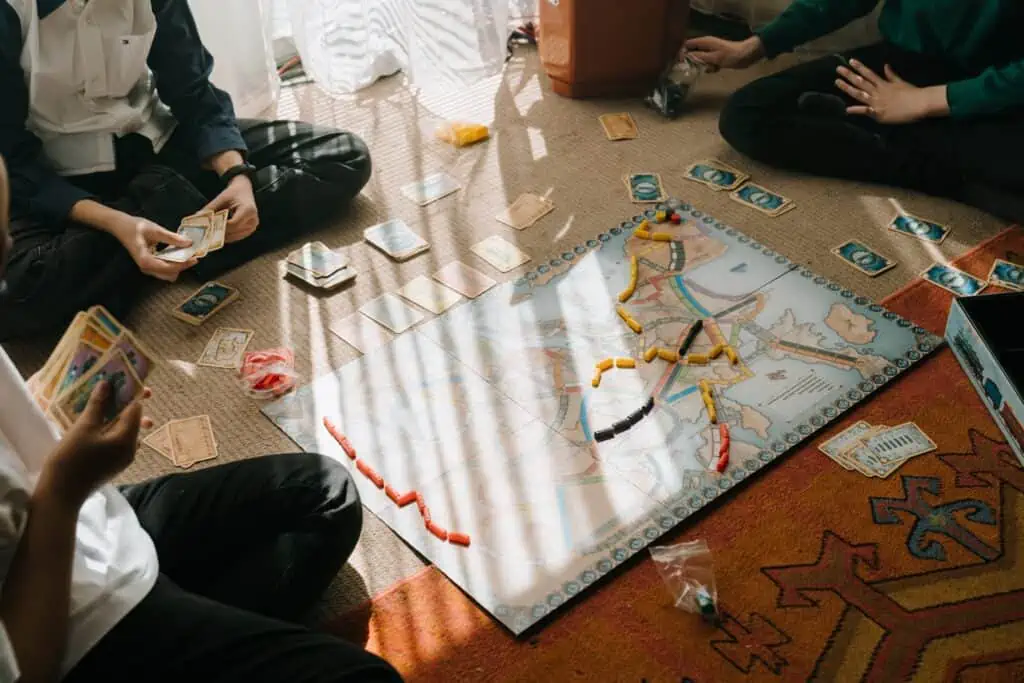What is play therapy?
Play therapy is essentially therapy conducted through the medium of play. Play therapy dates back to Sigmund Freud during the early twentieth century. Clinicians quickly realized the value of play and its therapeutic benefits for children while in the therapy room. They incorporated the use of board games, dolls, sand tray work, artwork, dramatization, and more to both observe and communicate with young clients.
Though play therapy is generally used for kids ages 3-12, adults can benefit from play therapy too. Adult clients working with inner-child issues related to trauma as well as adults who lack effective communication skills can benefit from play therapy.

Types of Play Therapy
There are countless types of play therapy used today. Typically, there are two categories in which play therapy is initiated. The first is non-directive, in which the therapist might tell the child to play as they wish, providing them with dolls, board games, art supplies, books, and more. The second type of play therapy is called directive play therapy, in which the therapist might provide a topic or a goal for playing.
The non-directive approach, allows the therapist to observe how the child plays. In early sessions, many therapists use this type of play therapy as they are building trust and safety in the therapy room. From observation, therapists can assess levels of problem-solving skills, creativity, aggression, joyfulness, family dynamics, and more.
Later on, therapists may progress to what is known as directive play therapy, in which the therapist may provide a topic or goal for play therapy. For instance, a therapist might ask a child to use dolls depicting how the child interacts with friends at school.
How Play Therapy Benefits and Treats Children
There are many benefits of play therapy. For one, clients feel a sense of ownership over the therapy process as they feel more control playing than they might if they were sitting on a couch talking to an adult. Secondly, play is a natural and organic form of expression for kids, so they feel less intimidated to express themselves through play.

Thirdly, for those children lacking effective communication skills, play itself can communicate emotions, thoughts, and behaviors without the pressure of having to find the “right” words to express one’s self. Lastly, play acts as a bridge between the child and the therapist, helping to form a safe and trusting relationship between the two.
The therapist uses observations to gather information to help formulate hypotheses about what may be impacting the child’s thoughts, feelings, and/or behavior. They then intervene through directive play to help influence the child’s thoughts, feelings, and behaviors in a positive way in order to improve their lives outside of the therapy room.
How Play Therapy Treats and Benefits Some Adults
As mentioned briefly, inner-child work can be conducted via play therapy. There are many adults who suffered severe trauma during their childhood and subsequently, their inner child essentially gets “stuck.” In the present, the inner child gets triggered, impacting the adult in negative ways. The idea is, that if we can heal the inner child and heal the childhood trauma, we can improve life for the adult client.

Play therapy can also be useful for adults who lack effective communication skills. Therefore, non-verbal clients, clients with brain injuries, clients with autism, and/or clients with communication disorders may all benefit from various forms of play therapy.
How Play Therapy Treats and Benefits Autism
Autism is a disorder that’s considered a spectrum disorder, meaning there is a wide range of how clients present with this diagnosis. The spectrum includes clients who are non-verbal, all the way to highly functioning communicative clients. Part of the defining characteristic of autism is the inability or difficulty to read social cues.
Play therapy can therefore benefit those with autism as they form a relationship with their therapist. Role-playing might be one type of play therapy intervention used with autistic clients to help them practice social skills in a safe environment.
How Play Therapy Treats and Benefits ADHD
Attention Deficit Hyperactivity Disorder is one of the more common mental health diagnoses today. People with this disorder struggle with a variety of issues, including difficulty focusing on long or complicated tasks, reading social cues, impulsivity, aggression, and more. Play therapy can be beneficial for clients with ADHD in a number of ways.
For one, play can be broken up into smaller segments, helping the client to feel empowered to set their own limitations and goals. Secondly, role-playing and dramatization can be utilized to help clients better understand social skills. Lastly, art has been shown to be very effective for clients with limited focusing capacity and therefore may prove to be a helpful medium of expression for those living with ADHD.
Is Play Therapy Effective?
While there are many promising studies on the effectiveness of play therapy, the general public may mistakenly believe it’s ineffective due to the time it takes to see results. Play therapy can be a slow process since much of it requires observation on the therapist’s part.
Children are also hesitant to trust adults and building a trusting relationship takes time. So, while it may not be directly related to the play therapy itself, these two aspects contribute to the misconception that it is a time-consuming endeavor and therefore less effective than other techniques.
Play Therapy Techniques
There is no one way to go about play therapy with a client. Typically, a therapist will meet the child and introduce them to their therapy room, showing them all the options for playing. They may discuss the “rules” of play, which in non-directive play therapy, include few if any. Then they allow the child to play.

The therapist will likely sit on the floor with them or match their height level depending on where they are playing. This helps establish a more equitable power dynamic. The goal of therapy is for the child to feel comfortable enough to express themselves freely, lending insight to the therapist.
The therapist then uses the information gained from these sessions to formulate a treatment plan and interventions. These interventions will typically evolve to include more goal-oriented forms of play with the intention of improving emotions, thoughts, and behaviors. Sessions typically range from 30 minutes to an hour, depending on the child’s age or the mental capacity of the client.
Examples of Play Therapy
While there are many examples of play therapy, art therapy, doll therapy, and role-playing tend to be the most utilized.
Art therapy includes having the child paint, draw, or use clay to express themselves. The therapist might ask questions about their creations which leads to deeper conversations in an organic manner. The client too may gain insight from their own creations, helping them to better understand themselves.
Doll therapy includes having children use dolls to demonstrate various dynamics in their lives. This might include asking the child to show what family dinners look like in their home. This can be very revealing and help the therapist to better understand family roles and levels of power within the home.
Role-playing can help improve social skills. Role-playing can also help children to “try on” other personas and see how it feels to incorporate other personality dynamics. Children gain empathy, confidence, and social skills as they master the art of role-playing.
Things to Consider
Ultimately, the most important thing for any client is to feel safe and comfortable with their therapist. No matter how skillful or educated a therapist might be, they will be ineffectual if safety and trust aren’t established.
When researching therapists who specialize in play therapy, it’s important to assess their level of expertise, what type of clients and diagnoses they work with, and what they predict as potential timelines for treatment. Play therapy is a wonderful technique and can be highly successful for many clients when paired with an effective and experienced therapist.





